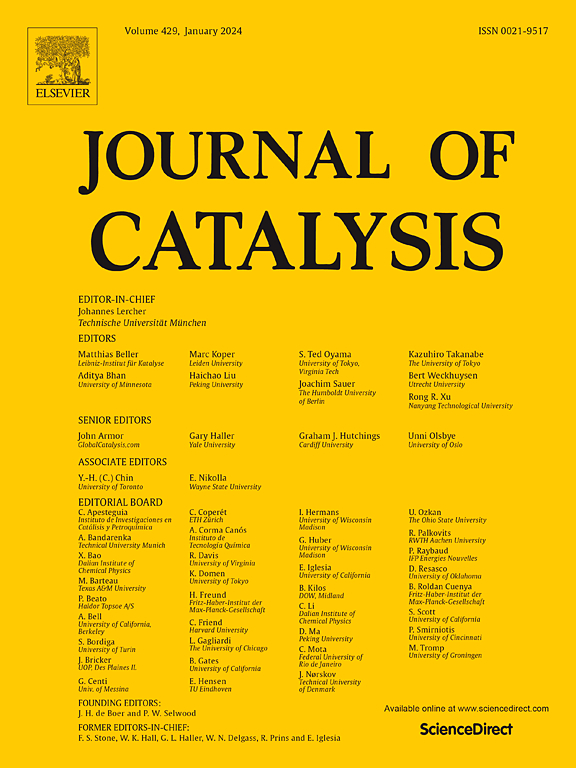MXene上的位置控制非金属单原子实现了高性能的氧还原电催化
IF 6.5
1区 化学
Q2 CHEMISTRY, PHYSICAL
引用次数: 0
摘要
单原子催化剂(SAC)结构中催化活性位点的战略性定位是材料性能的关键决定因素,特别是在像MXenes这样的二维(2D)底物中,它提供了复杂的结构复杂性和多种锚定潜力。尽管对非金属单原子催化剂的兴趣日益浓厚,但对位点特异性加载机制及其相应的催化意义的全面理解仍未得到充分探索。本文中,我们系统地研究了经济上可行的非金属元素-碲(Te)和砷(As) -在Ti3C2 MXene上的精确结合,Ti3C2 MXene是一种典型的二维材料,具有特殊的结构通用性。我们的方法描述了一种微妙的可控单原子固定化方法,策略性地区分了空缺嵌入和表面支持的配置。通过细致的实验设计,我们证明策略性集成在钛空位中的Te单原子(C-TeSA-T)比表面锚定的Te单原子(W-TeSA-T)表现出更好的氧还原反应(ORR)电催化性能。综合表征显示了显著的电催化指标,包括相对于RHE的半波电位为0.88 V,极限电流密度为5.65 mA/cm2。协同密度泛函理论(DFT)计算和多势x射线光电子能谱(XPS)分析阐明了内在的机制图景,最终确定了Te单原子为一级催化中心,并描绘了决定速率的反应轨迹。这项系统的研究不仅为设计具有成本效益的非金属催化剂提供了一个创新的范例,而且为活性位点定位和催化性能之间的复杂关系提供了基本的机制见解,从而促进了我们对二维材料中位点特异性催化的基本理解。本文章由计算机程序翻译,如有差异,请以英文原文为准。


Position-controlled non-metal single atoms on MXene enable high-performance oxygen reduction electrocatalysis
Strategic localization of catalytically active sites within single-atom catalyst (SAC) architectures represents a pivotal determinant of material performance, particularly in two-dimensional (2D) substrates like MXenes, which offer intricate structural complexity and multifarious anchoring potentialities. Despite the burgeoning interest in non-metallic single-atom catalysts, a comprehensive understanding of site-specific loading mechanisms and their consequential catalytic implications remains substantially unexplored. Herein, we systematically investigate the precise incorporation of economically viable non-metallic elements—tellurium (Te) and arsenic (As)—onto Ti3C2 MXene, a prototypical 2D material characterized by exceptional structural versatility. Our methodology delineates a nuanced approach to controllable single-atom immobilization, strategically differentiating between vacancy-embedded and surface-supported configurations. Through meticulous experimental design, we demonstrate that Te single atoms strategically integrated within titanium vacancies (C-TeSA-T) manifest superior Oxygen Reduction Reaction (ORR) electrocatalytic performance compared to surface-anchored counterparts (W-TeSA-T). Comprehensive characterization revealed remarkable electrocatalytic metrics, including a half-wave potential of 0.88 V vs. RHE and a limiting current density of 5.65 mA/cm2. Synergistic Density Functional Theory (DFT) computations and multi-potential X-ray Photoelectron Spectroscopic (XPS) analyses elucidated the intrinsic mechanistic landscape, conclusively identifying Te single atoms as primary catalytic centers and delineating the rate-determining reaction trajectory. This systematic investigation not only introduces an innovative paradigm for designing cost-effective non-metallic catalysts but also provides fundamental mechanistic insights into the intricate relationship between active site localization and catalytic performance, thereby advancing our fundamental understanding of site-specific catalysis in two-dimensional materials.
求助全文
通过发布文献求助,成功后即可免费获取论文全文。
去求助
来源期刊

Journal of Catalysis
工程技术-工程:化工
CiteScore
12.30
自引率
5.50%
发文量
447
审稿时长
31 days
期刊介绍:
The Journal of Catalysis publishes scholarly articles on both heterogeneous and homogeneous catalysis, covering a wide range of chemical transformations. These include various types of catalysis, such as those mediated by photons, plasmons, and electrons. The focus of the studies is to understand the relationship between catalytic function and the underlying chemical properties of surfaces and metal complexes.
The articles in the journal offer innovative concepts and explore the synthesis and kinetics of inorganic solids and homogeneous complexes. Furthermore, they discuss spectroscopic techniques for characterizing catalysts, investigate the interaction of probes and reacting species with catalysts, and employ theoretical methods.
The research presented in the journal should have direct relevance to the field of catalytic processes, addressing either fundamental aspects or applications of catalysis.
 求助内容:
求助内容: 应助结果提醒方式:
应助结果提醒方式:


